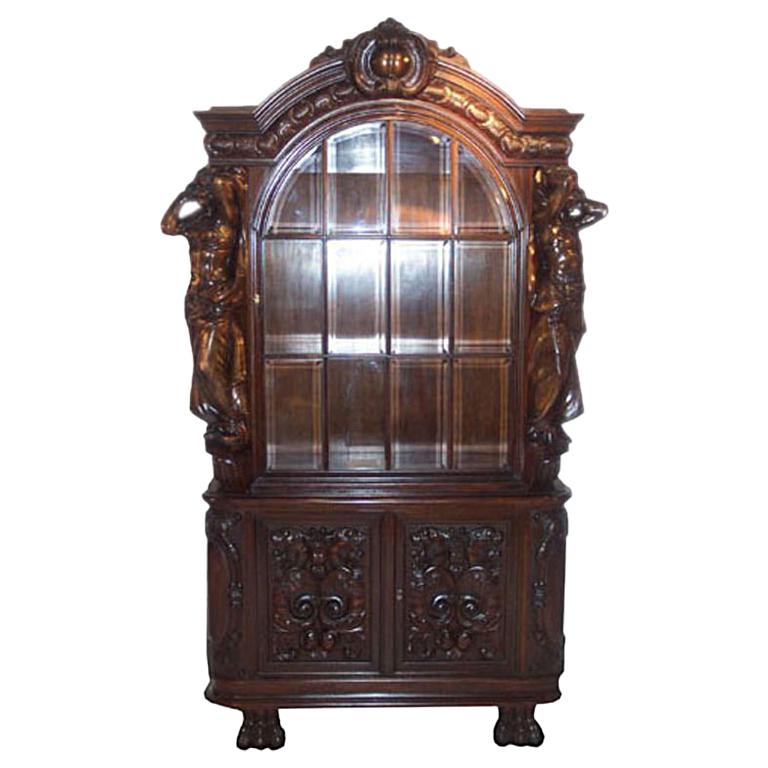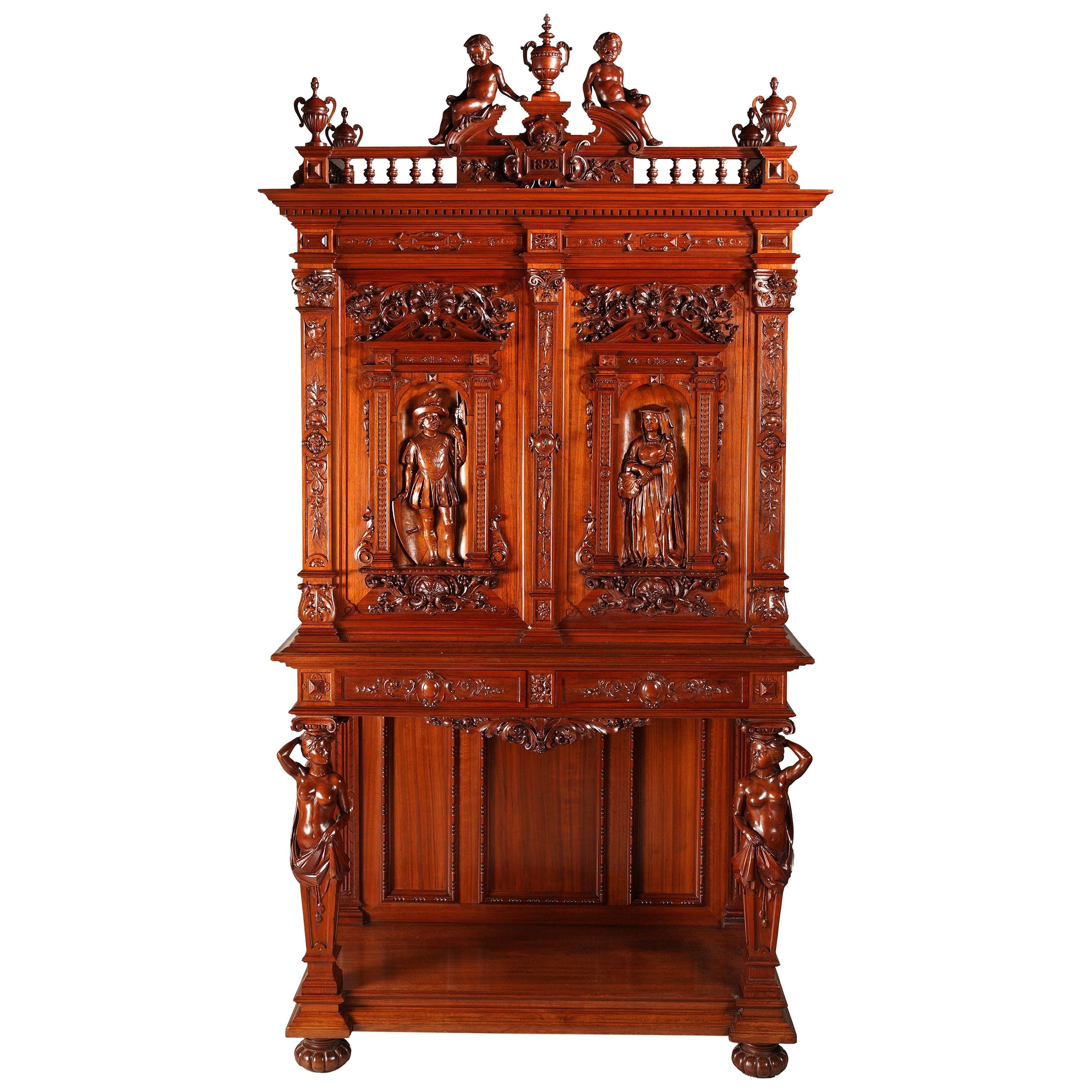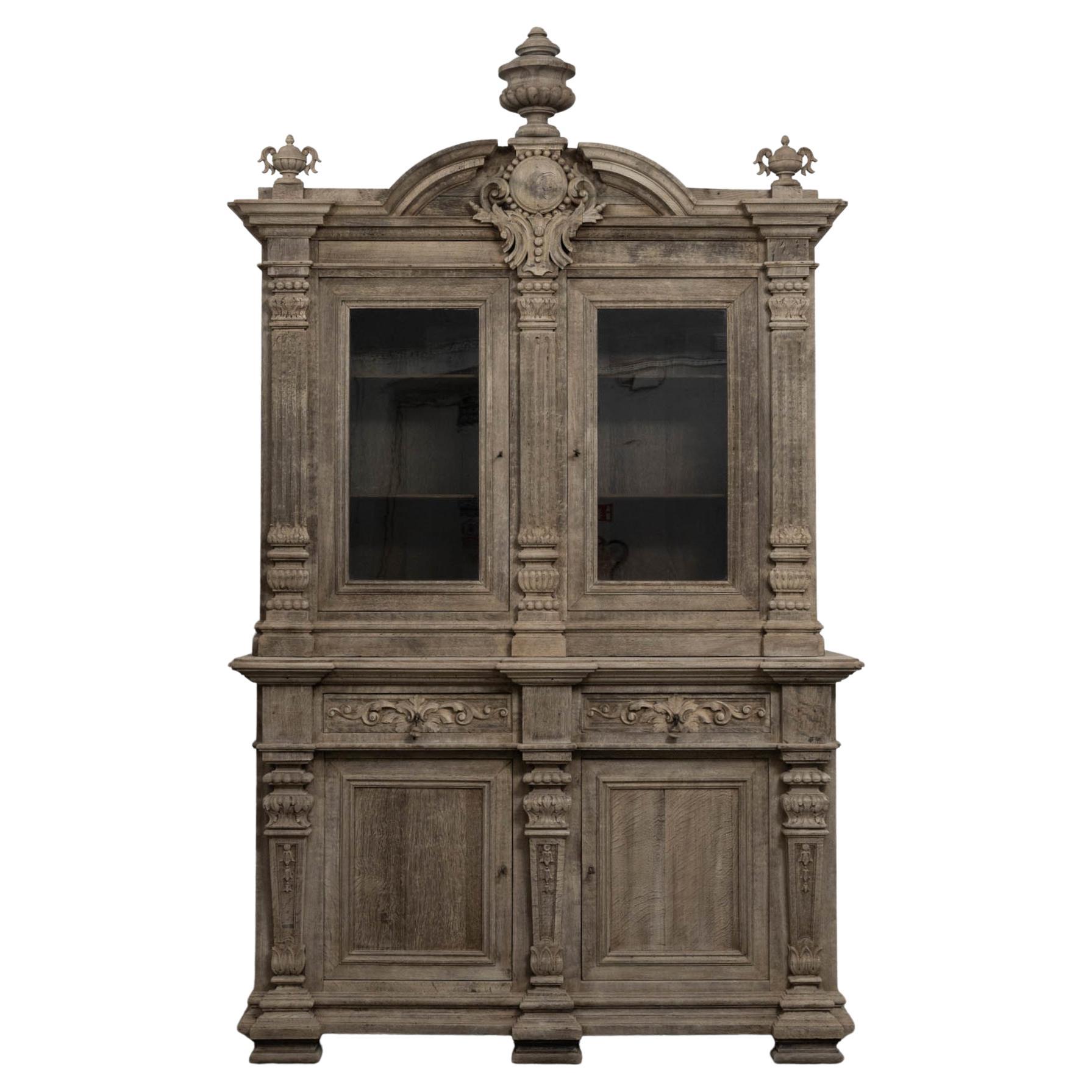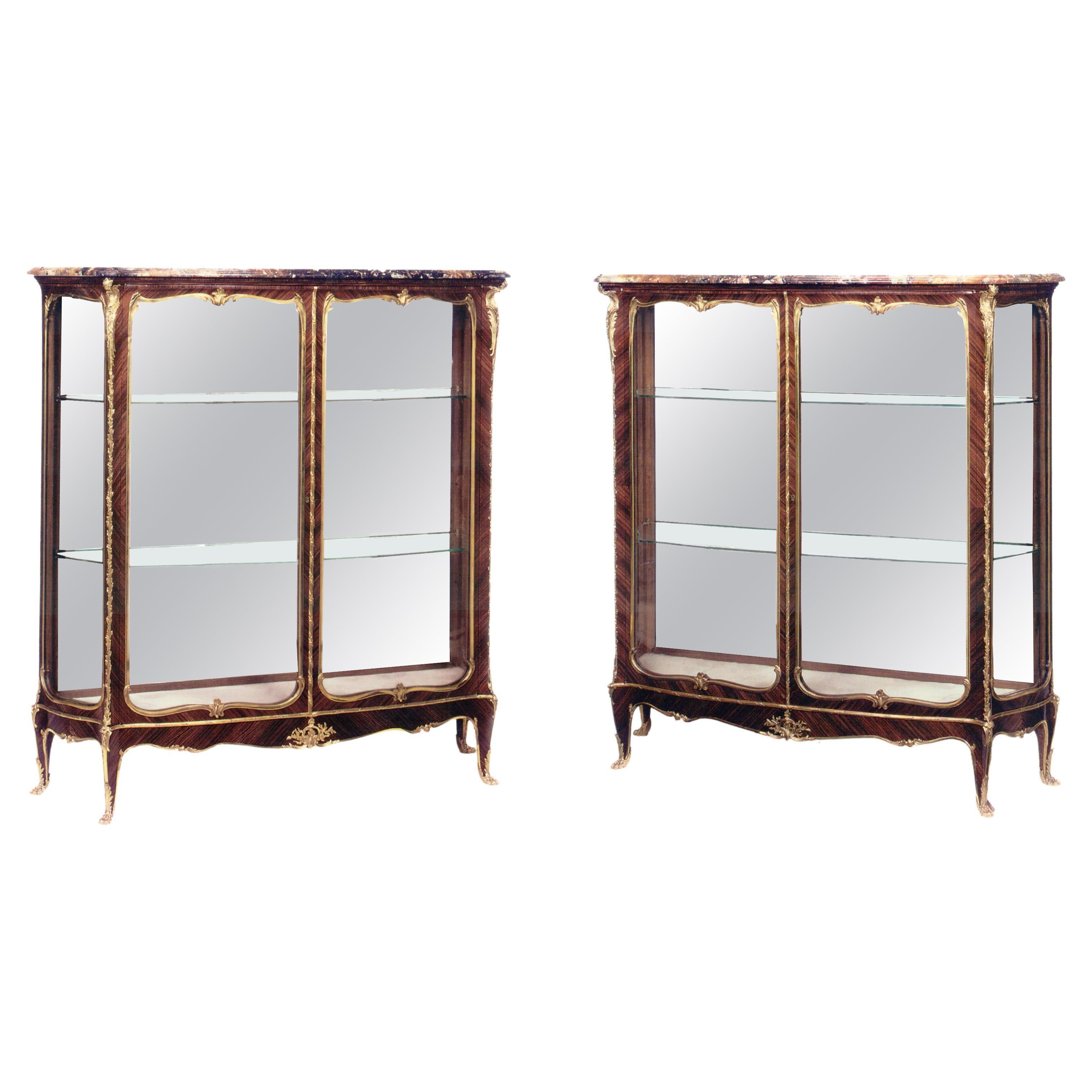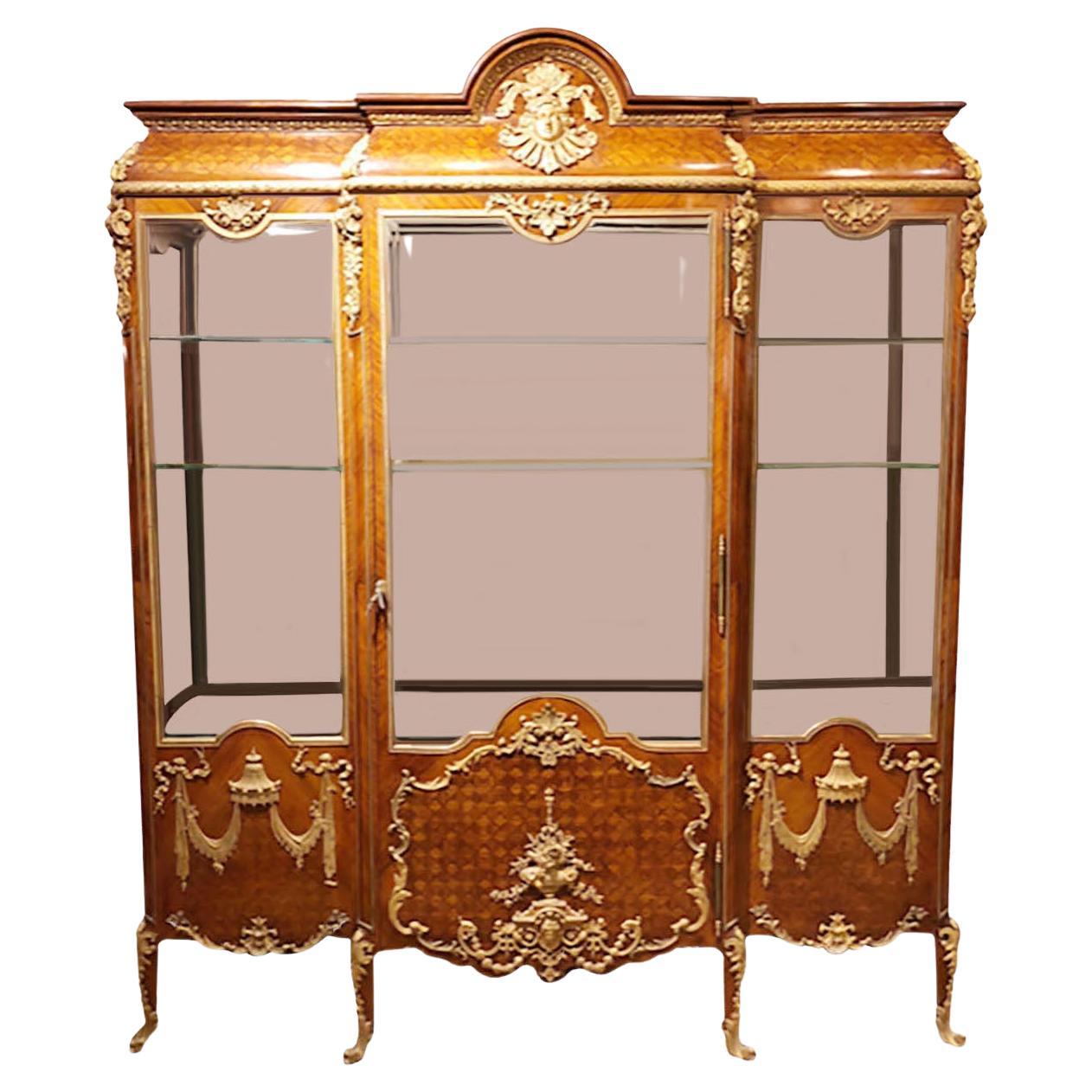Items Similar to Pair of Neo-Renaissance Vitrines, Attributed to H-A Fourdinois, France, c. 1860
Want more images or videos?
Request additional images or videos from the seller
1 of 10
Pair of Neo-Renaissance Vitrines, Attributed to H-A Fourdinois, France, c. 1860
About the Item
Fine pair of neo-Renaissance vitrines in richly carved wood, with three glazed sides framed by a relief frieze. Each opening to a drawer decorated with interlacing on the belt, and to a front door, they have two glass shelves. The uprights are composed of a couple of terms ending in a sheath, supporting a capital with acanthus leaves. They rest on lion paws and are topped with a green breccia molded marble top.
The Fourdinois company was founded in 1835 by Alexandre-Georges Fourdinois (1799-1871). The Universal Exhibition held in London in 1851 was undoubtedly their first great artistic and public success. Winning the Great medal for a neo-Renaissance buffet triggered a competition among other cabinetmakers, as the press was unanimously greeting their success. His son Henri-Auguste (1830-1907) was taught design by the architect Duban, then by the silversmith Morel in London, before working with the bronze founder Paillard. He joined the firm in 1860. His talent and the high quality of his designs drew attention at the 1862 World Exhibition in London, where the jury awarded him two medals for « Excellence in Composition and Execution ». Henri-Auguste, now sole in charge, brought the firm to the summit of its achievements at the 1867 Universal Exhibition in Paris by winning the Grand Prix (classes 14 and 15) as well as at the 1878 Exhibition. The 1862-1880 period marks truly the peak for the Fourdinois house, which remains for many cabinet-makers, whether French, English or American, an example to follow.
- Attributed to:Henri-Auguste Fourdinois (Cabinetmaker)
- Dimensions:Height: 42.52 in (108 cm)Width: 44.49 in (113 cm)Depth: 19.69 in (50 cm)
- Sold As:Set of 2
- Style:Renaissance Revival (In the Style Of)
- Materials and Techniques:
- Place of Origin:
- Period:
- Date of Manufacture:circa 1860
- Condition:Wear consistent with age and use.
- Seller Location:PARIS, FR
- Reference Number:
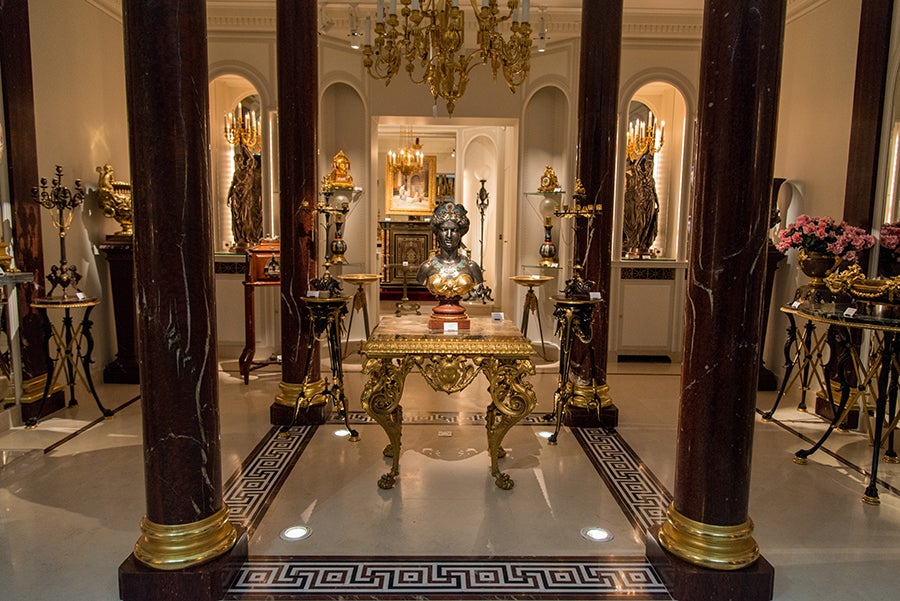
About the Seller
4.9
Vetted Seller
These experienced sellers undergo a comprehensive evaluation by our team of in-house experts.
Established in 1997
1stDibs seller since 2018
76 sales on 1stDibs
Typical response time: <1 hour
Associations
International Confederation of Art and Antique Dealers' Associations
- ShippingRetrieving quote...Ships From: Saint Ouen, France
- Return PolicyA return for this item may be initiated within 7 days of delivery.
More From This SellerView All
- Renaissance Style Wooden Cabinet Attributed to H.A. Fourdinois, France, 1893Located in PARIS, FRA wooden cupboard, elaborately carved throughout, dated "1893" on the crest and attributed to H.A. Fourdinois. The upper section with a pair of cherubs at the center of a balustrade ornamented with two-handled urns, two architectonic doors below, carved with lady and gentleman in niches surrounded by extensive carving with classical motifs. The lower section with two drawers above a standing female caryatid support at each front corner. The all reposing on four gadronned round feet. The Fourdinois company was founded in 1835 by Alexandre-Georges Fourdinois (1799-1871). The Universal Exhibition held in London in 1851 was undoubtedly their first great artistic and public success. Winning the Great medal for a neo-Renaissance buffet...Category
Antique 1890s French Renaissance Cabinets
MaterialsWood
- Pair of Armchairs Attributed to H.A. Fourdinois, France, c1870Located in PARIS, FRImportant pair of armchairs attributed to H.A. Fourdinois, with a flat back in “chapeau de gendarme” centered with a carved and foliated cartouche, joining padded scroll armrests car...Category
Antique 1870s French Renaissance Armchairs
MaterialsWood
- Pair of Louis XV Style Vitrines Attributed to J.-E. Zwiener, France, Circa 1885By Joseph-Emmanuel ZwienerLocated in PARIS, FRRare pair of Louis XV style gilt-bronze mounted curved shape vitrines attributed to J.E Zwiener. Glazed on all sides, they open with two doors framed by gilded and chiseled Rocaille style foliated bronze mounts. Resting on four cabriole legs ending with lion’s paws, the whole is covered by a « brèche de Benou » marble top. This model was probably designed by L. Messagé. Joseph-Emmanuel Zwiener was born in Germany in 1849. In 1880 he sets up his extensive workshops in rue de la Roquette in Paris where he creates many original pieces of furniture. He imitated practically every style, ranging from ‘’Boulle’’ to Louis XVI and including extraordinary personal interpretations of the Louis XV ‘’exuberant’’ style. He participated in the 1889 Universal Exhibition, held in Paris, and was awarded the gold medal for his remarkable copy of that most famous piece of furniture, Louis XV’s desk. The catalogue of the exhibition included a wonderful elegy qualifying the work as perfect : « No criticism what-so-ever could be made ». As that other famous cabinet-maker François Linke, Zwiener had most of his bronzes modelled by Léon Messagé whose work was considered as being of the best possible quality. Léon Messagé is a renowned designer and sculptor who integrated in his ornaments related to the Rocaille asymmetry, new lines and shapes announcing the “Art Nouveau” style. But even though, Messagé found inspiration with these 18th century artists, such as Nicolas Pineau or J. A. Meissonier, he didn’t simply copy their work and showed great originality, even extravagance, with some designs contained in "Cahier des dessins et croquis style Louis XV". He realized numerous sketches on grey paper before the execution of a reduced or life sized model of his ornaments, made of wax or terra-cotta. From 1885, Léon Messagé started working with important Parisian cabinet...Category
Antique 1880s French Louis XV Vitrines
MaterialsMarble, Bronze
- "Japonisme" Vitrine Attributed to A. Giroux, France, Circa 1880By Maison GirouxLocated in PARIS, FRRare aesthetic movement showcase, opening in its upper part by two beveled glass doors framed by brass moldings, in its lower part by two door panels in carved walnut decorated with blooming branches and gilded bronze ornaments representing dragons and birds. The sides are carved, like wicker woven. This showcase is topped by an important carved and gilded walnut cornice depicting a Fô Dog in its center, with a protective power, and rests on elephant head with overtuned trunk shaped feet. This type of elephant head with overtuned trunk shaped feet is a characteristic of the Maison Giroux, which can be found on many objects they produced. Aesthetic movement cabinet, signed Maison Alphonse Giroux...Category
Antique 1880s French Japonisme Vitrines
MaterialsBronze
- Vitrine Attributed to J.E. Zwiener and L. Messagé, France, Circa 1890By Joseph-Emmanuel ZwienerLocated in PARIS, FRElegant vitrine in veneered wood and gilded bronze. Opening with two curved doors with foliated frame in gilded and chiseled bronze, it is composed in the upper part of bevelled glas...Category
Antique 1890s French Louis XV Vitrines
MaterialsMarble, Bronze
- Wooden & Enameled Display Sideboard Attributed to H.A Fourdinois, France, c1867Located in PARIS, FRImportant two-tiered sideboard attributed to H.A. Fourdinois made in natural and carved wood : the lower part made up of four panels, two concave ones and two doors, richly ornated with a polychrome enameled floral decoration and gilt bronze plaques. A large dual drawer is surmounted by the upper part of the sideboard, opening with two glazed doors, framed by detached columns. The entire unit is topped with a pediment onto which a female bust is carved in relief within a medallion on a gilt background. With a matching set of twelve chairs. The Forney library in Paris preserves order registers of the Fourdinois as well as sketches books and pictures representing pieces of furniture made by the Fourdinois workshops. In this documentation, some elements enable us to link this sideboard with Henri-Auguste Fourdinois’ productions, such as the large scrolls linking the upper part to the lower part of the sideboard, as well as the detached columns carved at their lower third. (picture n°1 attached) Notebook containing ink-sketches coming from the Fourdinois workshop shows a project for a pelmet, beautified with a centering trophy composed of a torch and a quiver within in a foliage wreath, this motif obviously reused by the Fourdinois on the central decoration of the panels of our sideboard. (picture n°2 attached) The firm of Fourdinois, considered during the Second Empire as the greatest furniture manufacturer in Paris, was founded in 1835 by Alexandre-Georges Fourdinois (1799-1871). It was developped in the context of the Expositions Universelles. At the time, the firm already produces furniture of the Neo-Renaissance style, such as a dresser that won the Great Medal at the London Universal Exhibition of 1851. The son, Henri-Auguste Fourdinois (1830-1907), joined the firm in 1860 and will become head of the firm in 1867. The high quality of his designs was remarked at the Universal Exhibition in 1862, when the jury awarded him two medals « for Excellence of Composition and Execution ». Henri-Auguste, now sole in charge, brought the firm to the summit of its achievements at the 1867 Universal Exhibition in Paris by winning the Grand Prize for his stand. Apart from the commissions he executed for the « Mobilier de la Couronne », he also produced high quality furniture for the Parisian bourgeoisie. The firm is at its zenith during the years 1862-1880. At this time, it is considered as an example to follow for other cabinet-makers, whether they are French, British or American. Through the quality of execution and the extreme care taken in the decoration of furniture, H.-A. Fourdinois was particularly appreciated by Napoleon III and Eugenie...Category
Antique 1860s French Renaissance Sideboards
MaterialsEnamel, Bronze
You May Also Like
- Neo Renaissance VitrineLocated in Pompano Beach, FLSolid oak, ornately carved. Large glass vitrine with interior shelves above 2 doors with interior shelves. Austro-Hungarian circa 1860/80. Part of ...Category
Antique 19th Century Vitrines
- Neo Renaissance VitrineLocated in Pompano Beach, FLA Neo Renaissance Vitrine manufactured within the southeast of old Austro-Hungarian monarch, Baron Bethelen Castle. Private estate Beclean-Romania. R...Category
Antique 19th Century Vitrines
- 1860s Belgian Oak VitrineLocated in High Point, NCMagnificent and ornate, this antique oak vitrine cuts an impressive figure. Built in Belgium in the 1860s, the design is inspired by the elaborate furniture of the Renaissance. Beaut...Category
Antique 1860s French Renaissance Revival Vitrines
MaterialsGlass, Oak
- Kingwood Vitrine Attributed to GrimardBy Maison GrimardLocated in Dallas, TXA Kingwood vitrine attributed to Maison G. Grimard, a well known French Ebenistes de art in the 19th century. The Ormolu mounted cabinet and frame are mounted with acanthus leaves an...Category
Antique 1890s French Vitrines
MaterialsBronze
- Antique French Buffet 18th Century Renaissance Carved Oak Vitrine BookcaseLocated in Labrit, LandesNeo renaissance vitrine antique French buffet 18th century Hand carved oak with a mythological scene. Hercules and the bull Glass door display cabine...Category
Antique Late 18th Century French Renaissance Revival Buffets
MaterialsOak
- 19th Century Dutch Renaissance Wall VitrineLocated in Dallas, TX19th century Dutch Renaissance Wall Vitrine is perfect for keeping a collection of small valuable items dust-free and on full display! Hand-crafted from o...Category
Antique 1870s Dutch Renaissance Revival Vitrines
MaterialsArt Glass, Oak
Recently Viewed
View AllMore Ways To Browse
Circa 1860 Bronze
French Sole
Two Pairs French Doors
Two Pairs Of French Doors
English Renaissance Furniture
Antique French Press
French Press Antique
Relief Frieze
H High Sons
American Renaissance Furniture
Exhibition 1862
Exhibition Quality Carved
Renaissance Paris
1851 London Exhibition
Renaissance Cabinet Wood
Lion 1860
Pair Of Glass Front Cabinets
Pair Of French Doors With Glass
